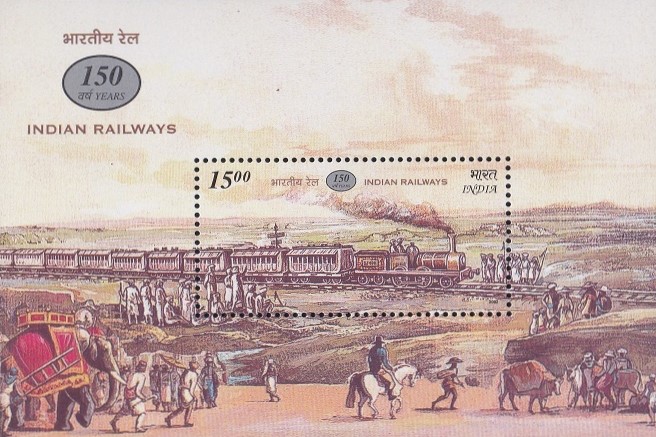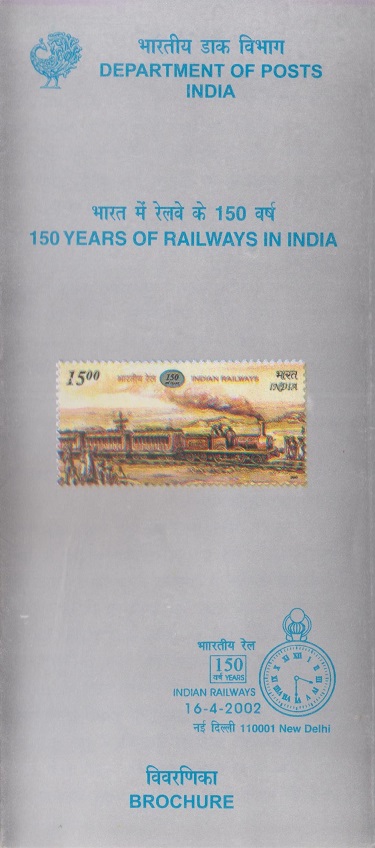
150 Years of Indian Railways
A miniature sheet consisting of 1 no. of commemorative postage stamp on the 150th Anniversary of Railways in India :



 Issued by India
Issued by India
Issued on Apr 16, 2002
Issued for : As the country braces itself to observe an year-long celebration to mark the 150th anniversary of India’s first train journey which falls in 2003, the Department of Posts tries to capture the spirit of the event with the issue of this commemorative stamp.
Design : The design of the stamp (and the miniature sheet) tries to re-create the Indian landscape of 1853, with the first train chugging away in the distance, on its journey to Thane on the 16th of April. The First Day Cover is an artist’s impression of the old Byculla Railway Station, located on the track connecting Bombay to Thane. A station master’s watch showing the time when the train commenced its historical journey from Bombay is shown on the design of the first day cancellation.
Credits :
Stamp, FDC and Cancellation : Sankha Samanta (Based on material furnished by the National Rail Museum, New Delhi)
Type : Miniature Sheet, Mint Condition
Colour : Six Colour
Denomination : 1500 Paise
Overall size : 5.25 x 2.62 cms.
Printing Size : 5.25 x 2.62 cms.
Perforation : 13.5 x 13.5
Paper : Matt Chromo
Stamps Printed : 3.0 million
Miniature Sheet : 1,00,000
Number per issue sheet : 27
Printing Process : Photo Offset
Printer : Calcutta Security Printers Ltd.
About :
- Railways have been a great integrating force in India for more than a century, particularly so after the attaining of independence in 1947. It has bound the economic life of the country and helped in accelerating the development of industry and agriculture. It has brought together people from the farthest corners of the country and made possible the conduct of business, education, pilgrimage and tourism.
- The history of Railways in India began on 16th April 1853, when the first train steamed off from Boribunder to Thane, covering a distance of 34 kilometres. From such a modest beginning, the Indian Railways have grown into a large network of about 7,000 stations spread over a route length of nearly 63,000 kms. Today it is one of the largest organisations in the world, employing a work force of 16 lakhs. It provides the principal mode of transport for freight and passengers in India.
- The Railway network runs multi gauge operations with the broad gauge, meter gauge and narrow gauge tracks. The network is divided into nine zones. Seven new zones and nine new divisions are further being set up. Each day about 7500 passenger trains carry more than 11 million passengers in different parts of the country.
- Text : Based on India 2001 (Publications Division) and material furnished by sponsors.








[…] and set up an art studio in Delhi in 1942. During this period he produced some unique paintings on Indian Railways and the Posts and Telegraphs Department. He also worked as an Art Director for some […]
[…] National Rail Museum was set up by the Indian Railways in 1971, to preserve and exhibit items of historical interest and the technical development, made […]
[…] of BSNL/DoT and to other Government and Private Organisations. Trainees from organisations like Railways, Defence, MP Electricity Board, Vihaan Networks, Department of Posts, IIITDM Jabalpur, IIIT […]
[…] most unpredictable behaviour. The first ever bridge across the Brahmaputra was constructed by the Indian Railways in 1962 at Saraighat near Guwahati. Incidentally, the second bridge is also being constructed by […]
[…] Indian Railways has stood as an emblem of progress spanning over 150 years. In this period, it catalyzed India’s industrialization and has emerged as a lifeline of India’s development. Some railway structures are monumental in nature representing significant developments in architecture and technology. On 15.08.1854 a train ran from Howrah to Panduah. This Heritage Run is commemorated by the release of a set of four stamps representing four Metro Heritage Railway Stations of India. The Miniature Sheet brings alive the old world charm of Railway Stations. […]
[…] a plague epidemic. The plight of the people moved Shri Pingali Venkaiah. He quit his job in the Railways and obtained training as Work Inspector and worked as a Plague Disease Eradication Inspector in […]
[…] Life Line Express, in partnership with Indian Railways, is the world’s first hospital on rails. The Life Line Express, one of the projects of Impact […]
[…] Indian Railways are associated with the International Union of Railways since 1957. The Union recently celebrated […]
[…] Himalayas have since time immemorial enchanted saints, pilgrims and tourists for various reasons. Railways, in their own way, have tried to ‘ascend’ the […]
[…] some long tunnels – the tunnel in Karbude (Ratnagiri) is 6.5 kms in length, the longest in the Indian Railway System. Some tall viaducts also needed to be built, such as the one in the Panval Nadi valley in […]
[…] Corbett got a job in the Railways at Mokameh Ghat in Bihar at the age of 18. He worked as Fuel Inspector and later as Assistant […]
[…] India eventually emerged in a blaze of glory when during the first half of extra time Balbir Singh (Railways) gave a pass to his inside right and receiving it back swooped into the circle and scored a goal […]
[…] phase he developed the qualities of tolerance, self-reliance and determination. He joined the Railways, but left the service soon for the domain of language and literature, his first love. As a […]
[…] Railways started in India in 1853. With the widening of the railway network the railway workshops also came into prominence and became an integral part of the railway system. […]
[…] he was forced to work after completing his matriculation from Thane. He started his career in Railways and Postal Department before finally joining the Mandavi Textile Mill as a Store Keeper. Life was […]
[…] Integral Coach Factory has the distinction of manufacturing the first stainless steel coach for Indian Railways. From design and development, to manufacturing and after-sales service of coaches, the Integral […]
[…] the end of 1942, the activities of the SPE were extended to include cases of corruption in the Railways, which was strategically concerned with the movement and supply of war […]
[…] Swarup Bhatnagar Prize for Science and Technology. The institute has produced 7 chairmen of the Indian Railway Board, chairman of the Telecom Regulatory Authority of India, more than a 100 secretary-level […]
[…] fearlessness and zeal for accomplishment. He was born in 1906. He was mainly working in the Railway and Mill Workers Union. He was at the forefront of the labour movement. He worked hard to get more […]
[…] evolution of the Trade Union Movement in the world, several small unions started coming up in the Indian Railways during the British Regime. The basic reason behind formation of such unions was serious racial […]